Interviewer Guide for Dentists
CDC and ATSDR Health Message Testing System
GUIDE - Dentist_CLEARED_2019-10-02
Message and material testing for the Be Antibiotics Aware (BAA) campaign for healthcare providers (HCPs)
OMB: 0920-0572
Form Approved
OMB Control No.: 0920-0572
Expiration date: 8/31/2021
FINAL – DHQP and NCEZID cleared
Antibiotic Use Educational Effort – Interviewer Guide
Healthcare Provider (HCP) – Dentists
Welcome, rules, ice breaker/intro [2-3 minutes]
Thank you for taking the time to join us for this interview. My name is [INSERT NAME] and I work for ICF, a private firm, who is conducting research on behalf of the US Centers for Disease Control and Prevention, or CDC, who is sponsoring this health communication campaign. I want to take a few minutes to tell you what to expect from our conversation and go over the informed consent.
ICF is conducting this study on behalf of CDC to learn about antibiotic prescribing by dentists and to gather feedback on communication materials for CDC’s campaign to raise awareness about antibiotic resistance and improve antibiotic use. This information will be used to improve the materials that you see.
Remember your participation is voluntary. That means you can stop us at any time and if you are uncomfortable with a question, or if you simply don’t have a response, it is fine to pass.
Our discussion should take about one hour. Your name and any identifiable information you may share during our discussion will not be included in our final report, so no responses will be linked to you directly. I don’t expect you to tell me anything that you would be uncomfortable sharing, but hope that you will be honest with your responses to the questions I ask.
Please speak up and speak clearly. We are audiotaping the discussion so that we can have an accurate record of the discussion. We have observers from CDC and ICF listening and taking notes during our discussion today. We also have a technology support person to assist with any with any technical needs during our discussion.
Do you have any questions before we get started?
Begin recording and ask:
We are now recording this session. I want to ask you again:
Do you agree to participate in this interview?
Do you consent to us recording your responses?
Understand providers’ perceived role in improving antibiotic prescribing and gathering information about participants preferred sources of information about antibiotic prescribing. [10 minutes]
Ok, great. Let’s get started. I’d like to start our conversation by hearing your thoughts on antibiotic prescribing and where you get information about it.
In a typical week, how often do you prescribe antibiotics in your individual clinical practice?
PROBE: Do you encounter any challenges with antibiotic prescribing in dentistry? If so, what are they?
PROBE: Do you have any challenges with determining when a patient should be treated with an antibiotic for an infection? If so, what are they?
PROBE: Do you have any challenges with antibiotic prophylaxis? If so, what are they?
Do you think dentists or dental practices have a role to play in improving antibiotic prescribing?
PROBE: [If yes] What is that role?
PROBE: [If no] Why?
PROBE: Do you take any actions to improve prescribing? If so, what are they?
PROBE: What actions does your practice take?
Ok, let’s talk a little bit about where you get information about antibiotic prescribing.
What resources, in general, do you refer to when prescribing antibiotics?
PROBE: American Dental Association guidance, guidelines, or recommendations?
PROBE: American Heart Association guidelines for antibiotic prophylaxis?
PROBE: American Academy of Orthopedic Surgeons guidelines for antibiotic prophylaxis?
PROBE: Any others?
What resources would be helpful for you to learn more about and implement recommended antibiotic prescribing practices in dentistry?
PROBE: What about webinars or educational trainings?
PROBE: What about mobile apps?
PROBE: What about websites?
PROBE: What about information in an electronic health record?
Have you ever seen, heard, or read any TV, radio, newspaper, or online advertising about Be Antibiotics Aware?
PROBE: [If yes] Where have you seen or heard about Be Antibiotics Aware?
On TV?
On Social media?
Through e-mail?
On a website?
Gather feedback on CDC materials that can help to optimize antibiotic prescribing in dentistry - Test Checklist for Antibiotic Prescribing in Dentistry fact sheet [15 minutes]
In the last few minutes, we discussed your thoughts around antibiotic prescribing. Now, let’s move on to our first material. Take a few minutes to read this and then we’ll discuss (give 3-4 minutes to read).
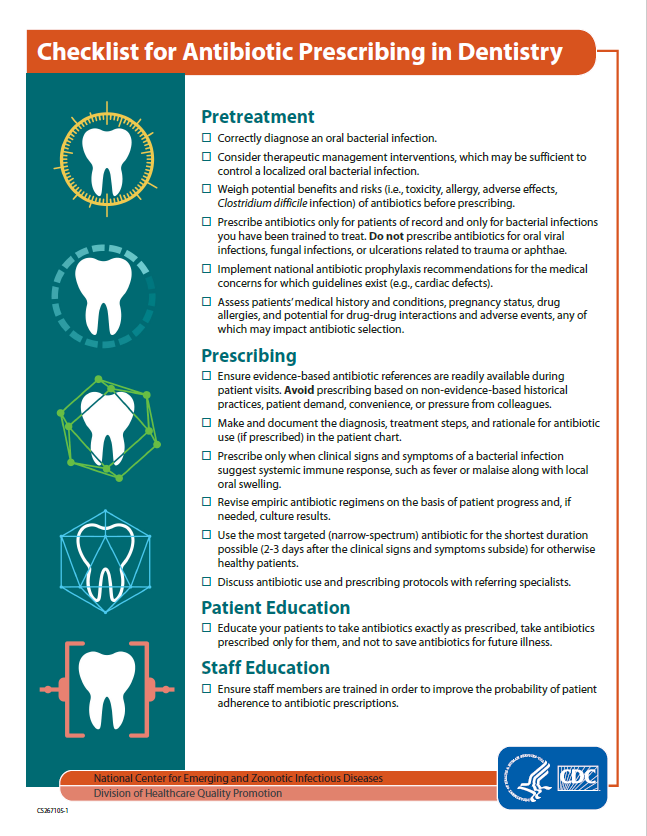 https://www.cdc.gov/antibiotic-use/community/downloads/dental-fact-sheet-FINAL.pdf
https://www.cdc.gov/antibiotic-use/community/downloads/dental-fact-sheet-FINAL.pdf
Let’s start with some questions about the content in this fact sheet.
What action(s) seem the easiest for you to perform in your clinical practice? Why?
Which actions on this fact sheet are the most challenging to perform?
PROBE: Why?
PROBE: What are the barriers that would not allow you to perform this action(s)?
PROBE: What would make it easier for you to perform this action(s)?
What do you think is the most important action in this fact sheet?
PROBE: Why?
 Ok,
let’s look specifically at one action in this fact sheet,
Prescribing.
Ok,
let’s look specifically at one action in this fact sheet,
Prescribing.
Do you ever feel pressure from other healthcare providers to prescribe prophylactic antibiotics for procedures when they aren’t indicated?
PROBE: [If yes] Can you tell me more? Do you ever feel pressure from patients to prescribe antibiotics when they aren’t indicated?
What type of information or materials do you think would help you have discussions with other healthcare providers about antibiotic prescribing?
Ok, let’s go back to looking at this fact sheet as a whole.
What do you like about this fact sheet?
PROBE: What about the length of this material?
How could this fact sheet be improved?
PROBE: Is there anything that is confusing or needs clarification?
PROBE: Is there anything you want to know that this fact sheet doesn’t tell you? (HMTS 6d)
Would you use this fact sheet?
PROBE: [For “No”] Why?
PROBE: [For “Yes”] How?
Overall, if provided to dentists, how helpful do you think this fact sheet is /would be for antibiotic prescribing in dentistry?
PROBE: [For any response] Why?
Now I have a few questions about the visual aspects of this piece.
What do you think about the layout of information in this fact sheet?
Overall, how appealing is this material to you? (HMTS 7e)
Would it catch your attention if you saw it somewhere? (HMTS 9e) Would you stop to read it?
Where would you expect to find this material for you to use?
PROBE: What about from a dental professional society?
PROBE: What about on CDC’s website?
Gather feedback on CDC materials that can help to optimize antibiotic prescribing in dentistry - test 7 Ways Dentists can Be Antibiotics Aware poster [15 minutes]
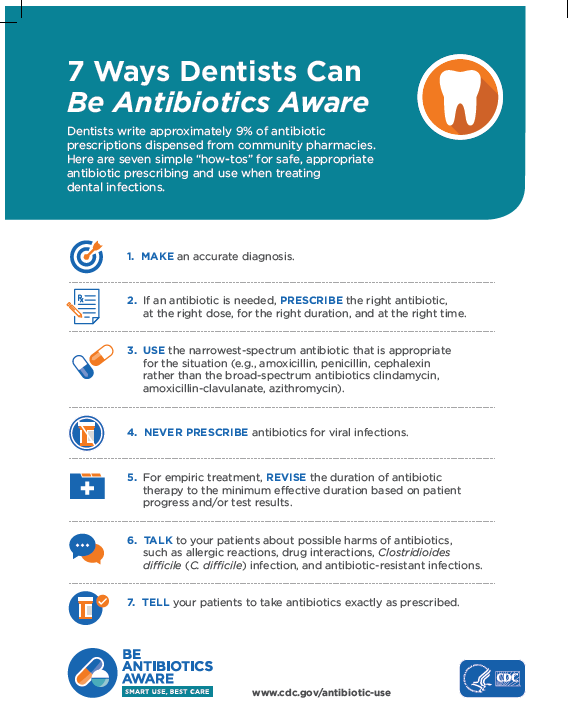 Ok,
let’s move on to our second material. Take a few minutes to
read this and then we’ll discuss (give 2-3 minutes to read).
Ok,
let’s move on to our second material. Take a few minutes to
read this and then we’ll discuss (give 2-3 minutes to read).
https://www.cdc.gov/antibiotic-use/week/pdfs/7-Ways-Dentists-AR-508.pdf
What action(s) seem the easiest for you to perform in your clinical practice? Why?
Which actions on this fact sheet are the most challenging to perform?
PROBE: Why?
PROBE: What are the barriers that would not allow you to perform this action(s)?
PROBE: What would make it easier for you to perform this action(s)?
What do you think is the most important action in this fact sheet?
PROBE: Why?
What do you like about this fact sheet?
PROBE: What about the length of this material?
How could this fact sheet be improved?
PROBE: Is there anything that is confusing or needs clarification?
PROBE: Is there anything you want to know that this fact sheet doesn’t tell you? (HMTS 6d)
Would you use this fact sheet?
PROBE: [For “No”] Why?
PROBE: [For “Yes”] How?
Overall, if provided to dentists, how helpful do you think this fact sheet is /would be for antibiotic prescribing in dentistry?
PROBE: [For any response] Why?
Now I have a few questions about the visual aspects of this piece.
What do you think about the layout of information in this fact sheet?
Overall, how appealing is this material to you? (HMTS 7e)
Would it catch your attention if you saw it somewhere? (HMTS 9e) Would you stop to read it?
Where would you expect to find this material for you to use?
PROBE: What about from a dental professional society?
PROBE: What about on CDC’s website?
Ok, let’s look at these two fact sheets side by side.
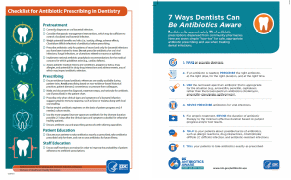
Which fact sheet is more appealing to you? Why?
PROBE: [For the fact sheet not chosen] Why is this one less appealing to you?
Which fact sheet are you more likely to use?
PROBE: [For either response] Why?
[For the fact sheet the participant identified they wouldn’t use] Why are you less likely to use this fact sheet?
PROBE: Can you suggest any changes that would make it more usable / helpful for you?
Gather feedback on the Do you need antibiotics from your dentist? brochure that can help dentists educate their patients about antibiotic use, focusing on adverse events of antibiotics. [15 minutes]
H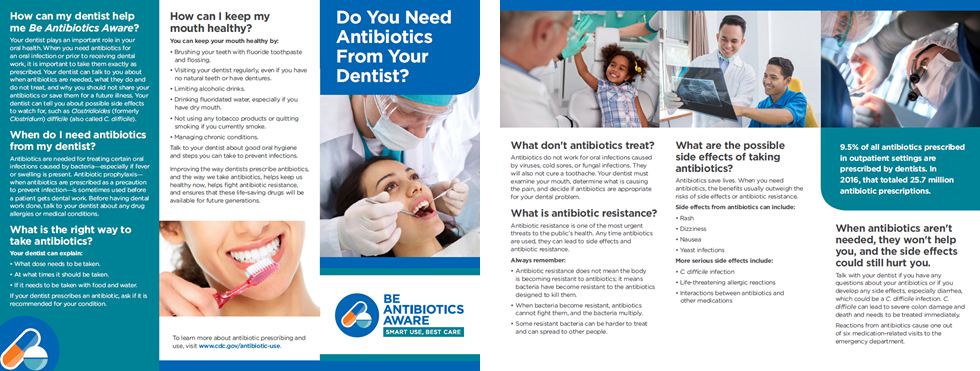
ere’s
our last material. Please take a few minutes to read though it before
I ask questions (give 4-5 minutes).
https://www.cdc.gov/antibiotic-use/community/pdfs/Antibiotics-Dentist-Brochure-508.pdf
What’s your general reaction to the way this brochure looks? (HMTS 6e)
PROBE: What do you think about the layout of the information?
PROBE: What do you like about this brochure?
PROBE: How could this brochure be improved?
Overall, how helpful do you think this brochure is / would be in educating your patients about appropriate antibiotic use in dentistry?
PROBE: [For any response] Why?
PROBE: [For “Not helpful”] Would putting this information in a different format be more helpful to provide education to your patients? If so, what format?
PROBE: Would you use this brochure to educate your patients? Why or why not?
PROBE: Is there anything else that your patients ask you about antibiotic use that isn’t covered in this brochure?
PROBE: Is there anything your patients should know about antibiotic use that isn’t covered in this brochure?
Are there any other types of materials or resources that you think would be helpful to educate patients about appropriate antibiotic use?
PROBE: What about a poster that could be placed in a dental office?
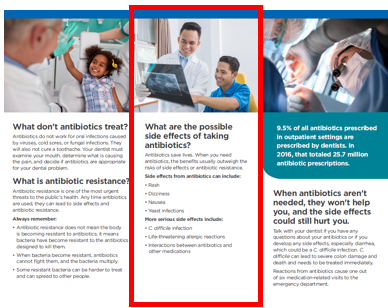 Let’s
look specifically at the side effects section in this brochure:
Let’s
look specifically at the side effects section in this brochure:
In a typical week, how often do you talk to your patients about possible side effects related to antibiotic use?
PROBE: How do you generally counsel your patients on antibiotic-related side effects?
PROBE: What side effects do you typically talk to them about?
PROBE: What about C. difficile infection?
Do you think this section would help you educate your patients about possible antibiotic-related side effects?
PROBE: [For yes or no] Why?
PROBE: Is there any other information about antibiotic side effects that your patients ask you that isn’t covered in this section?
PROBE: Is there anything your patients should know about antibiotic use side effects that isn’t covered in this section?
Closing [2-3 minutes]
Well, that’s the last of my questions. Do you have any comments or questions that you’d like to bring up before we end our discussion?
Thank you again for taking the time to participate in this discussion. Please visit www.cdc.gov/antibiotic-use for more information on appropriate antibiotic prescribing.
We sincerely appreciate and value your input!
Public reporting burden of this collection of information is estimated to average 60 minutes per response, including the time for reviewing instructions, searching existing data sources, gathering and maintaining the data needed, and completing and reviewing the collection of information. An agency may not conduct or sponsor, and a person is not required to respond to a collection of information unless it displays a currently valid OMB Control Number. Send comments regarding this burden estimate or any other aspect of this collection of information, including suggestions for reducing this burden to CDC/ATSDR Reports Clearance Officer, 1600 Clifton Road NE, MS D-74, Atlanta, Georgia 30333; ATTN: PRA 0920-0572
| File Type | application/vnd.openxmlformats-officedocument.wordprocessingml.document |
| Author | Wiedeman, Kathryn (CDC/DDID/NCEZID/DHQP) |
| File Modified | 0000-00-00 |
| File Created | 2021-01-15 |
© 2026 OMB.report | Privacy Policy